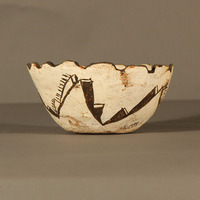Everyday Eating : Introduction
The principle function of the daily meal is to provide nourishment to the body. While some occasions are celebrated with elaborate displays of food, there is a consistency in the everyday meal. Meals are part of a regular routine that can be accompanied by family or a larger group setting even when they are not a part of a ceremony or celebration. The community atmosphere helps promote emotional well-being to go along with the actual eating. Although the intent is the same, the way we define an average meal can be varied depending on the context. It may be a quiet time to eat with family or alone, as depicted in the painting entitled “Breakfast.” However, a larger dining experience, such as would be served from the Ugqoko, would also be considered part of an ordinary proceeding. Similarly, the chow bowl is a representation of the communal midday break for workers during a long day in the rice fields. Finally, the Zuni bowl, while being functionally versatile, still upholds the sense of physical and social fulfillment. While these objects are often used in everyday setting, they still hold aspects of the ritual practices surrounding food in their respective cultures.
Things to think about:
How do you usually eat? Are you alone or with others?
Are there specific foods that you always eat?


